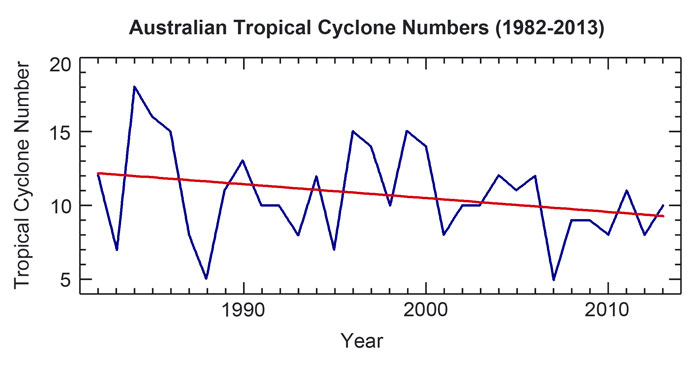| Tweet | Follow @co2science |
Paper Reviewed
Dowdy, A.J. 2014. Long-term changes in Australian tropical cyclone numbers. Atmospheric Science Letters 15: 292-298.
In a study published in Atmospheric Science Letters, A.J. Dowdy of the Centre for Australian Weather and Climate Research analyzes data pertaining to the seasonal numbers of tropical cyclones (TCs) observed throughout the Australian region of the southwestern Pacific Ocean over the 32-year period stretching from 1982 to 2013, which early start date eliminated, in his words, "potential satellite-induced data inhomogeneities prior to this period."
This effort revealed a decreasing trend in the yearly number of TCs experienced in this region over this time period (Figure 1); and in discussing this result, Dowdy writes that "one possible physical explanation for a decreasing trend in TC numbers could be a potentially long-term shift in environmental conditions towards a more El Niño-like state, given that fewer TCs tend to occur in the Australian region during El Niño than La Niña conditions."

Figure 1. Annual number of tropical cyclones in the Australian region of the southwestern Pacific Ocean over the period 1982-2013. Adapted from Dowdy (2014).
Further adding to the reality of his findings, the Australian researcher notes that "the decreasing trend in TC numbers shown here based on high quality observations is broadly consistent with results of previous studies examining TC occurrence in the region around Australia," citing the findings of Nicholls et al. (1998), who discovered "a decline in TC numbers near Australia using observations from 1970 to 1996 TC seasons," as well as the results of Callaghan and Power (2010), who "also reported a decreasing trend in TCs making landfall over eastern Australia, significant at the 90% level, based on reports from numerous historical sources (including peer-reviewed publications, newspapers, sea-faring observations and other media reports dating back to the late 19th century)."
And so we would appear to have another example wherein the claims of proponents of CO2-induced increases in the number of occurrences of various extreme weather events do not appear to jibe with what is observed in the real world of nature.
References
Callaghan, J. and Power, S. 2010. Variability and decline in the number of severe tropical cyclones making land-fall over eastern Australia since the late nineteenth century. Climate Dynamics 37: 647-662.
Nicholls, N., Landsea, C and Gill, J. 1998. Recent trends in Australian region tropical cyclone activity. Meteorology and Atmospheric Physics 65: 197-205.
Posted 27 February 2015



